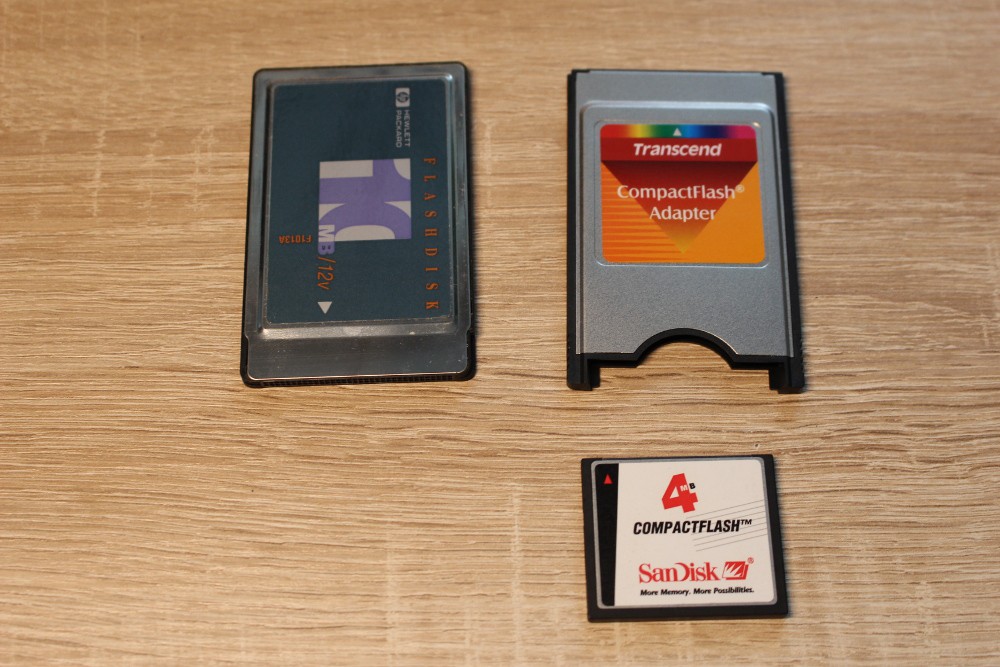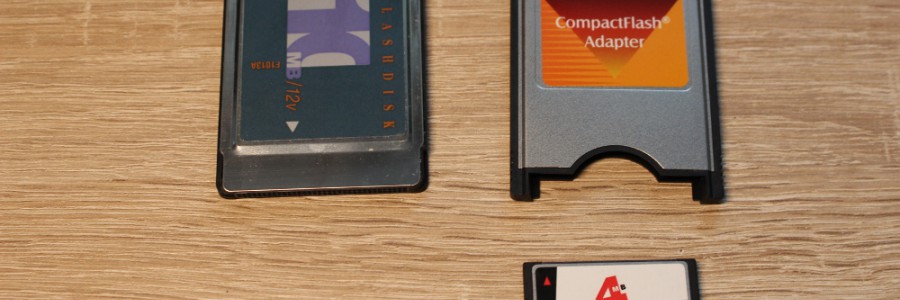The biggest problem with the HP 100LX and the HP 200LX is getting information on them. Unfortunately, many of the old websites that contained useful and important information went down. Luckily some are still available on Archive.org (such an awesome website!), but they can't be found on Google or DuckDuckGo anymore. So I decided to repost some of the most useful things here :)
Today we will look into CF cards and see how and which ones are supported.
Let's start with the adapters first. The problem is, CF cards don't fit into the palmtop's slot by themselves. Luckily CF cards can be connected to a PCMCIA slot by a simple, passive adapter. I am using this one you can buy from Amazon.

On the left, you can see an actual Flashcard from the same period. On the right, there is the CF card to PCMCIA adapter and on the bottom, you can see my 4 MB SanDisk CF card.
My 4 MB CF card is supported right out of the box. There is nothing else to do. Just access drive A in DOS. However, later cards with higher capacities don't work with DOS. For some cards, there is a driver available, called ACECARD3 which was developed to allow the use of modern cards in the HP 100LX and HP 200LX, by hooking into an interrupt and helping the BIOS to access these old cards.
You can download acecard3.zip from my website.
Installing the driver is rather simple. First, if you have not already done it, copy the files CONFIG.SYS and AUTOEXEC.BAT from the ROM-drive (D:) to the root of the RAM-Disk (C:). Now, unzip the acecard3.zip archive onto an FAT16 formatted CF card that has a capacity of 16 MB or less. The most compatible cards are manufactured by SanDisk (formerly known as SunDisk).
The next step involves copying the ACECARD3.COM file onto the root of the RAM-Disk (you can use the Filer application for this). Now start the Memo application and open the file C:\CONFIG.SYS. The following statement needs to be added to the file:
DEVICE=C:\ACECARD3.COM /SDPSave the file and then reboot by pressing Ctrl + Alt + Del.
If everything works fine, the driver should now be loaded and working. You can now insert the bigger, FAT16 formatted card. Make sure you have powered-off the palmtop before swapping cards!
Now let's get to the list of the supported CF cards (w/ and w/o adapter). The following table shows the CF cards that work or don't work on the 100LX and 200LX:
| Card | Palmtop | Compatibility | ||||||
|---|---|---|---|---|---|---|---|---|
| brand | capacity in MB | Type I=3mm II=5mm |
model# | model | BIOS ver. | works with Doublespeed upgrade | driver needed | comments |
| A-1 Flash | 256 | Type I | - | 200LX | 1.02A | yes | - | - |
| Apacer | 128 | Type I | - | 200LX | 1.01A | no | - | only tested in doublespeed palmtop, doesn't work. |
| Canon | 8 | Type I | FC-8M | 200LX | 1.02A | yes | - | - |
| EagleTec | 32 | Type I | - | 200LX | ? | ? | - | Very power-hungry, crashes palmtop on write access when batteries get low. Not recommended. |
| Kingston Technology | 64 | Type I | - | 200LX | 1.02A | probably | - | - |
| Kingston Technology | 128 | Type I | High Speed CF/128 9902366-001.A00 641603 | 200LX | 1.02A | some yes, some not. | - | Attention: Doesn't work with some double-speed palmtops! |
| Kingston Technology | 256 | Type I | THNCF256MAA | 200LX | 1.02A | yes | - | - |
| Kodak | 20 | Type I | Sundisk SDP 5/3 0.6 | 200LX | 1.02A | probably | - | - |
| Lexar | 16 | Type I | Marked CompactFlash USB Enabled 8x 16MB, P/N 2177, Rev A | 100LX | 1.03A | ? | acecard | Card is USB enabled |
| Lexar | 48 | Type I | CompactFlash 48MB 4X | 200LX | 1.02A | yes | - | Card is USB enabled |
| Lexar | 128 | Type I | CompactFlash 128MB 4X (or 12X), marked CF128-04-266 and USB Enabled, P/N 2175, Rev A | 200LX | 1.02A | yes | - | Card is USB enabled |
| Memorex | 64 | Type I | - | 200LX | 1.02A | probably | - | - |
| PQI | 32 | Type I | P/N FC032 | 200LX | 1.01A | - | acecard | problems reported, high power consumption, FAT problems, not recommended!, also strange that acecard driver is necessary. |
| PQI | 64 | Type I | - | 100LX/200LX/700LX | 1.02A | ? | - | reliability problems reported, not recommended!, also causes "card battery low" message in some cases. killmsg can avoid that. Relabeled e.g. as HAMA. |
| PQI | 64 | Type I | P/N FC064, 5Q62D and 164822200007 | 200LX | 1.02 | yes | acecard | - |
| Pretec | all | Type I | - | 200LX | all | - | - | reliability problems reported, not recommended! |
| Ritdata | 64 | Type I | - | 200LX | - | ? | on some 200LXes the acecard driver is needed | Labeled ExtreMemory |
| Ritdata | 256 | Type I | - | 200LX | - | ? | - | Labeled ExtreMemory |
| Robanton | 256 | Type I? | - | 200LX | - | yes | acecard | - |
| Sandisk | 4 | Type I | SDCFB | 100LX / 200LX | 1.02A | ? | - | recommended |
| Sandisk | 8 | Type I | SDCFB | 200LX | 1.02A | yes | - | recommended |
| Sandisk | 15 | Type I | - | 200LX | 1.02A | yes | - | recommended |
| Sandisk | 30 | Type I | SDCFB | 200LX | 1.02A | yes | - | recommended |
| Sandisk | 64 | Type I | SDCFB | 200LX | 1.02A | yes | - | recommended. Labeled "RCA" |
| Sandisk | 80 | Type I | SDCFB | 200LX | 1.02A | yes | - | recommended |
| Sandisk | 128 | Type I | SDCFB | 200LX | 1.02A | yes | - | recommended |
| Sandisk | 160 | Type I | SDCFB | 200LX | 1.02A | yes | - | recommended |
| Sandisk | 160 | Type II | - | 200LX | 1.02A | yes | - | recommended |
| Sandisk | 192 | Type I | SDCFB | 200LX | 1.02A | yes | - | recommended |
| Sandisk | 256 | Type I | SDCFB AR0203NX China | 200LX | 1.02A | probably | - | recommended |
| Sandisk | 512 | Type I | SDCFB Copyright 99 AX0110ML USA | 200LX | 1.02A | yes | acecard | recommended |
| Sandisk | 1 GB | Type I | BB0206NK CHINA Copyright 99 | 200LX | 1.02A | yes | acecard | recommended; seems to work in some devices (MP3 players...) where the 512MB card fails |
| Sandisk | 2 GB | Type I | SDCFB (not the 'ultra' version) | 200LX | 1.02A | yes | acecard | recommended |
| Simple Technology | 32 | Type I | - | 200LX | 1.02A | yes | - | - |
| Simple Technology | 48 | Type I | - | 200LX | 1.02A | yes | - | - |
| Simple Technology | 64 | Type I | markings 90000-00756-032 and 001002-FL1-001 | 200LX | 1.02A | yes | - | - |
| Simple Technology | 96 | Type I | - | 200LX | 1.02A | yes | - | - |
| Toshiba | 64 | Type I | THNCF064MMA | 200LX, 700LX | ? | ? | - | - |
| Toshiba | 256 | Type I | THNCF256MAA | 200LX | 1.02A | yes | - | Labeled Kingston Technology, "High speed" |
| Transcend | 128 | Type I | - | 200LX | 1.01A | yes | - | - |
| Twinmos Mediastore (TM) | 256 | Type I | Ultra High Speed Serialno: 251M52069330136 P/N:FCF256S Made in Taiwan | 200LX | 1.02A | yes | - | - |
| Verbatim | 32 | Type I | 0441CT4E | 200LX | 1.01A | probably | - | - |
| Verbatim | 128 | Type I | 021711 | 200LX | 1.02A | yes | - | - |
The table was taken from http://www.hermocom.com/hplx/view-all-hp-palmtop-articles/13-storagecards. It is hard to tell if the site will go down in the next time, so I am backing the information up here. The site has already moved the article so most links are broken by now. I hope this will be useful for other HP owners in the future :)
